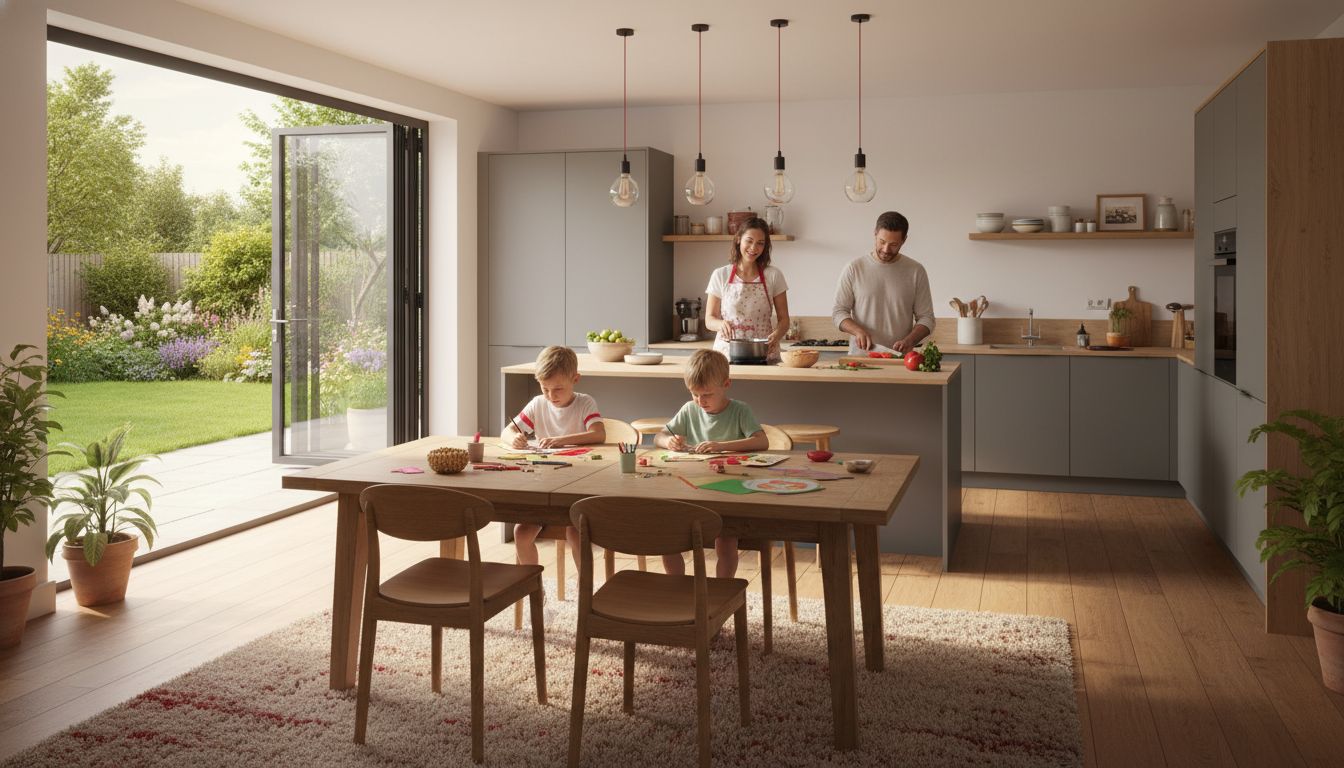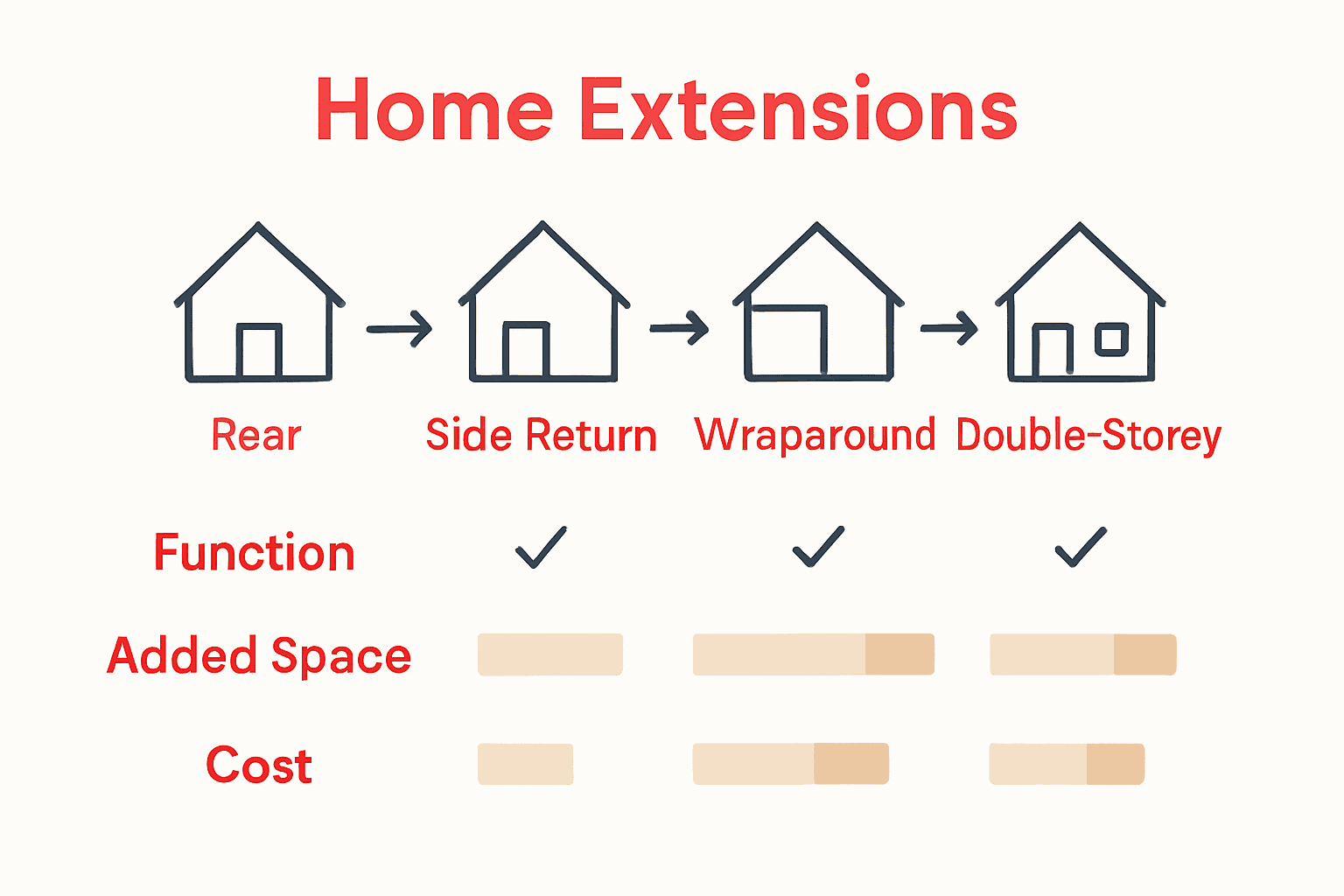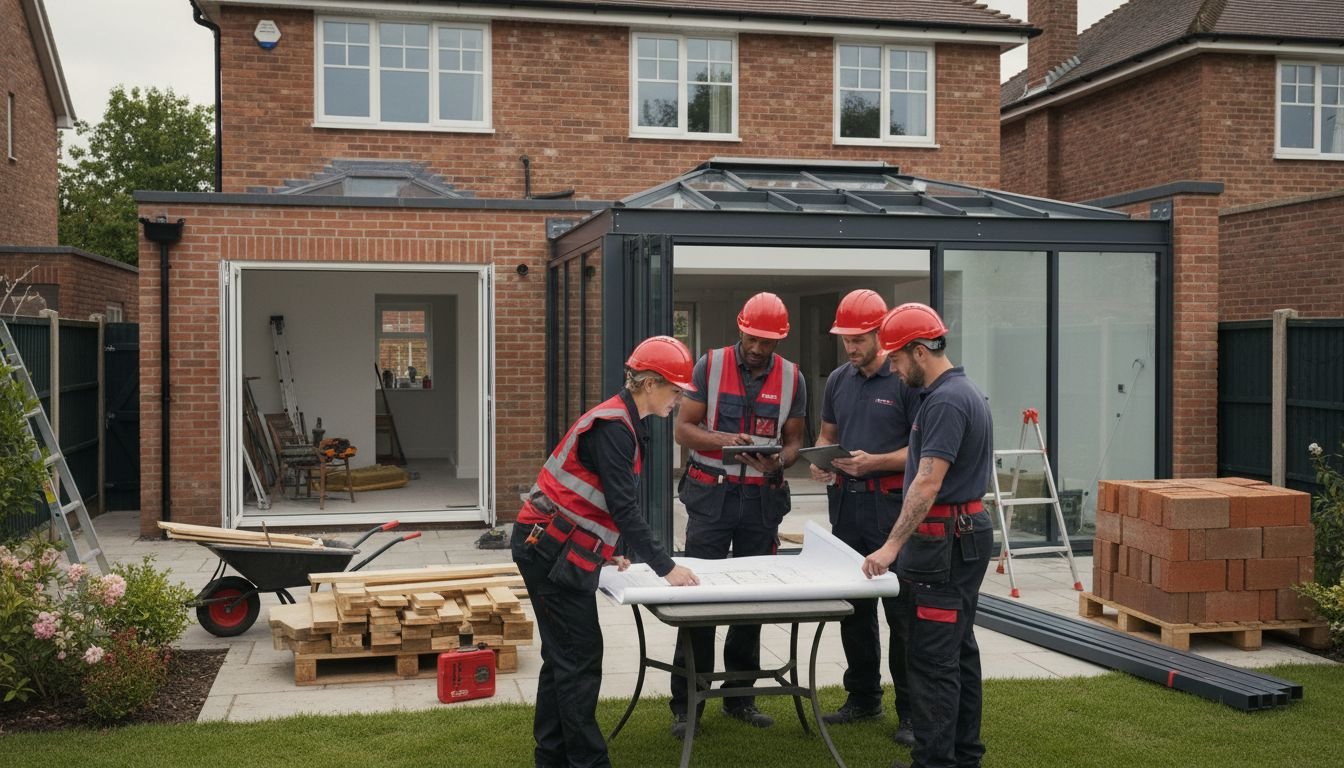Did you know that over 200,000 homeowners in the UK apply for residential extension approvals each year? Expanding your living space is often more practical and cost-effective than moving, especially as families grow and property prices rise. Choosing the right type of extension can add significant value, comfort, and flexibility to your home, transforming day-to-day life while navigating planning, costs, and design choices.
Table of Contents
- Defining Residential Extensions in the UK
- Popular Types of Home Extensions
- Planning Permission and Legal Requirements
- Key Steps in the Extension Process
- Costs, Funding, and Project Management
- Common Pitfalls and How to Avoid Them
Key Takeaways
| Point | Details |
|---|---|
| Types of Extensions | Various extension types (e.g., rear, side return, double-storey) cater to different needs and property types, influencing design and budget. |
| Planning Permissions | Understanding planning permissions and regulations is crucial; some extensions may fall under Permitted Development rights, avoiding lengthy approval processes. |
| Cost Management | Home extension costs can vary widely; effective budgeting and project management are essential to control expenses and avoid unexpected challenges. |
| Avoiding Pitfalls | Common pitfalls include neglecting planning permissions and underestimating costs; proactive planning and professional guidance can mitigate these risks. |
Defining Residential Extensions in the UK
A residential extension represents a strategic home improvement project designed to expand your existing living space by physically adding new rooms or areas to your property. Resi defines a house extension as a method of expanding your home by adding new functional spaces like a larger kitchen, extra bedroom, or additional floor, which effectively increases both the property’s size and overall functionality.
At its core, a residential extension transforms your current home’s footprint, allowing homeowners to create additional living areas without the significant expense and disruption of moving to a new property. These extensions can take multiple forms, ranging from ground floor expansions to second-storey additions, each tailored to meet specific household needs and architectural constraints. The primary goal remains consistent: maximising existing property potential while enhancing livability and potentially increasing market value.
Extensions typically fall into several key categories, including rear extensions, side return extensions, wraparound extensions, and double-storey extensions. Each type offers unique advantages depending on your property’s layout, local planning regulations, and personal requirements. Homeowners often pursue extensions to accommodate growing families, create open-plan living spaces, add modern amenities, or simply improve their home’s overall functionality and aesthetic appeal.
 Understanding the Various Types of Home Extensions can help you navigate the most suitable option for your specific circumstances.
Understanding the Various Types of Home Extensions can help you navigate the most suitable option for your specific circumstances.
Popular Types of Home Extensions
Homeowners in the UK have several distinctive home extension types to choose from, each offering unique spatial solutions. UK Home Improvement highlights the most common extensions, which include rear extensions, side return extensions, double-storey extensions, single-storey extensions, and wrap-around extensions.
Here’s a comparison of the most popular home extension types in the UK:
| Extension Type | Typical Location | Key Benefits |
|---|---|---|
| Rear Extension | Back of the property | Enhanced indoor-outdoor flow Ideal for large kitchens or living areas |
| Side Return Extension | Beside the property | Maximises unused space Creates wider open-plan rooms |
| Wraparound Extension | Rear and side combined | Maximum additional space Highly flexible design options |
| Double-Storey Extension | Rear or side (two floors) | Adds bedrooms and bathrooms Increases property value significantly |
| Single-Storey Extension | Rear or side (one floor) | Cost-effective expansion Suitable for kitchen-diners or utility areas |
| Lean-To Extension | Along existing wall | Simple structure Budget friendly improvement |
Each extension type serves specific architectural and lifestyle needs. Rear extensions typically extend living spaces at the back of the property, creating seamless indoor-outdoor connections. Side return extensions utilise narrow alleyways beside the property, transforming previously unused spaces into functional areas. Wraparound extensions combine rear and side extensions, offering maximum floor space and design flexibility. Homebuilding further emphasises the versatility of extension styles, noting lean-to extensions as another innovative option for property enhancement.
The choice of extension depends on multiple factors including property layout, budget, planning permissions, and personal aesthetic preferences. 7 Modern Extension Style Examples for Your Home can provide inspiration for homeowners looking to understand how different extension types might transform their living spaces. Whether you’re seeking to create an open-plan kitchen, add a home office, or generate additional living areas, there’s an extension style tailored to meet your specific requirements.

Planning Permission and Legal Requirements
Planning permission is a critical consideration for any home extension project in the UK. Homebuilding explains that determining the need for planning permission depends on multiple factors, including the extension’s type, size, location, and any prior planning conditions. Not all extensions require full planning approval, with some falling under Permitted Development rights.
Under current UK regulations, homeowners have specific allowances for extending their properties without formal planning permission. Homebuilding outlines precise guidelines: single-storey rear extensions can extend up to 4 meters for detached homes and 3 meters for semi-detached or terraced properties. Side extensions are subject to additional restrictions, including a width limit of half the original house width and a maximum height of 4 meters. Permitted Development Extensions can help you understand these nuanced regulations.
Navigation of these legal requirements can be complex, with variations depending on your specific property type, location, and local authority regulations. Key considerations include the proposed extension’s impact on neighbouring properties, conservation area restrictions, and potential listed building constraints. Professional guidance becomes crucial in understanding the intricate landscape of planning permissions, ensuring your home improvement project remains compliant and avoids potential legal complications.
Key Steps in the Extension Process
Resi outlines a comprehensive approach to home extensions, highlighting the critical stages that transform your home improvement vision into reality. The extension process begins with initial design and planning, a crucial phase where homeowners conceptualise their desired space and develop detailed architectural drawings that capture their specific requirements and property constraints.
The subsequent stages involve obtaining necessary permissions and selecting the right contractors. This includes navigating planning permissions, securing building regulation approvals, and carefully vetting potential construction teams. Homeowners must conduct thorough research, request multiple quotes, and verify contractors’ credentials, portfolios, and previous extension work. Extension Design Process: Step-by-Step Guide for Homeowners can provide additional insights into this critical selection process.
The final stages encompass the actual construction and comprehensive inspections to ensure compliance with building regulations. This phase requires meticulous project management, regular communication with contractors, and close monitoring of progress, budget, and quality. Unexpected challenges may arise, so maintaining flexibility and having a contingency budget is essential. Successful extensions not only expand your living space but also enhance your property’s overall value and functionality, making the detailed planning and execution process a worthwhile investment in your home’s future.
Costs, Funding, and Project Management
Home extension costs can vary dramatically across the UK. Livingetc reports that in 2025, single-storey extensions range between £1,800 and £3,500 per square meter, while double-storey projects cost between £1,650 and £3,250 per square meter. These figures underscore the significant financial investment required for home improvements, making comprehensive budget planning essential.
Homebuilding highlights additional expenses that homeowners must factor into their extension budgets. Beyond basic construction costs, these include VAT (typically 20%), planning permissions, building regulation fees, party wall agreements, potential utility upgrades, and comprehensive insurance. Unexpected access constraints or complex site conditions can further impact overall project expenditure.
Effective project management becomes crucial in controlling costs and ensuring a smooth extension process. This involves creating a detailed budget with contingency funds, maintaining clear communication with contractors, regularly monitoring progress, and being prepared to make informed decisions quickly. Extension Project Management Workflow Guide can provide homeowners with strategic insights into managing their extension project efficiently, minimising financial risks and potential delays while maintaining high-quality standards.
Common Pitfalls and How to Avoid Them
Homebuilding highlights several critical potential mistakes in home extension projects that can derail your renovation plans. The most significant pitfalls include failing to obtain necessary planning permissions, overlooking crucial building regulations, and neglecting potential impacts on neighboring properties. These oversights can result in costly delays, legal complications, and potentially mandatory dismantling of your extension.
Navigating the complex landscape of home extensions requires meticulous preparation and professional guidance. Common errors homeowners make include underestimating project costs, inadequate structural planning, and poor contractor selection. Unexpected challenges like hidden structural issues, utility complications, or boundary disputes can quickly escalate project expenses and timelines. Proactive strategies involve conducting comprehensive property surveys, maintaining transparent communication with local authorities, and ensuring all legal and regulatory requirements are thoroughly understood and addressed.
To mitigate risks, homeowners should prioritise professional consultation and comprehensive planning. Understanding the House Extension Approval Process recommends engaging experienced architects, obtaining multiple contractor quotes, creating detailed contingency budgets, and maintaining open communication with both professionals and neighbors throughout the extension journey. By anticipating potential challenges and implementing strategic planning, you can significantly reduce the likelihood of expensive mistakes and ensure a smoother, more successful home improvement project.
Transform Your Home with Expert Residential Extensions
If you have been exploring what a residential extension involves and feeling overwhelmed by planning permissions, design options, or project management challenges, you are not alone. Many homeowners struggle to navigate these complexities while trying to create more living space that perfectly fits their needs. Whether you are considering a rear extension, a wraparound, or a double-storey addition understanding the technicalities and costs can be daunting. Your goal is to maximise your property’s potential while avoiding costly mistakes and delays.
We understand these concerns and offer tailored solutions to help you bring your home extension vision to life with confidence. With over 20 years of experience in London and Surrey, we specialise in guiding you through every stage from initial design inspiration to seamless project management. See ideas that suit your style and requirements in our Extension Inspiration & Ideas for Your Home and discover the right approach in our Types of Home Extensions & Ideas. For peace of mind, learn how we manage your project efficiently in Project Management for Home Extensions.
Do not let uncertainty hold you back from enhancing your home today. Take the first step towards a stylish, functional, and legally compliant extension by contacting our expert team. Get in touch with us now at https://relticextend.co.uk/contact-us/ to start planning a personalised extension tailored to your unique needs and enjoy a smoother, stress-free renovation journey.
Frequently Asked Questions
What is a residential extension?
A residential extension is a home improvement project that expands your existing living space by adding new rooms or areas to your property, such as a larger kitchen, extra bedroom, or additional floor.
What types of residential extensions are available?
Popular types of residential extensions include rear extensions, side return extensions, wraparound extensions, double-storey extensions, and single-storey extensions. Each type serves different spatial and architectural needs.
Do I need planning permission for a residential extension?
Planning permission is required for many residential extensions, but some may fall under Permitted Development rights, allowing certain types of extensions without formal approval. It’s important to check local regulations before proceeding.
How much does a residential extension cost?
Costs for residential extensions vary widely. As of 2025, single-storey extensions can range from £1,800 to £3,500 per square meter, while double-storey extensions may cost between £1,650 and £3,250 per square meter.





